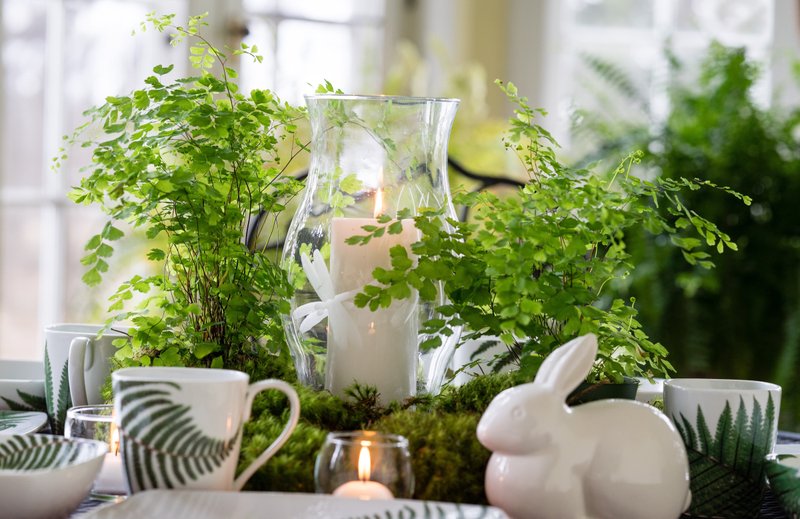Houseplants and I have a spotty record. Their survival around my place is hit and miss, mostly miss. If a houseplant does survive more than a few months in my house, its DNA ought to go straight to the stud-farm equivalent for houseplants. Of course, then I'd hurt those who make a living selling houseplants to people who kill them like the characters in a Quentin Tarantino movie.
That said, I support, in theory, the idea of houseplants as home decor. In fact, one of my design tenets is that every room should have something living in it: fresh flowers, a plant, a goldfish, a dog — and, no, that mold growing in the glass of orange juice you left sitting in the den last Tuesday doesn't count.
Living things bring rooms, well, to life. They make a static interior feel inhabited by offering proof that someone must live there or this living thing that needs nurturing wouldn't be there.
But here's the frank truth: I sometimes have trouble meeting my own standards. So when I got an advanced copy of Maria Colletti's Living Decor (Cool Springs Press), a modern guide to welcoming houseplants into our homes, I got the shot of courage and inspiration I needed to take another run at indoor greenery.
Colletti, who spent years working for the New York Botanical Gardens, begins her book with a (much-needed for me) primer on plant care. She follows that with specifics about today's most popular plant trends, including the urban jungle trend, characterized by giant tropical houseplants.
"Monstera madness is leading it," she told me when I called her to talk plants.
"Monstera madness?"
"It's a real thing," she insisted.
I need to get out more.
Her book, which is packed with lush-green images, also offers a satisfying section on ways to mix plants into your home decor, featuring updated planter ideas, hanging gardens and terrarium techniques.
After you plant yourself down with this pretty how-to manual, you, too, will want to spring for a few new plants. I did.
Now those of you out there with the botany gene, you may kindly move onto the sports section. For the rest of us who don't know a fiddle-leaf-fig from a philodendron, I asked Colletti for some advice.
For starters, she said, "Don't be afraid. Anyone can incorporate the natural beauty of houseplants into a home. It's really not that hard." Here's how:
• See the light. The most common reason plants fail is because people put the wrong plant in the wrong place. "Don't just plop a plant down because you like the way it looks on the coffee table," said Colletti, calling out my downfall. Know the light patterns in your home, and which way windows face. East-facing windows get strong, direct morning light. Southern windows get midday sun and are hot at noon. Western exposures stay hot into the evening. North facing windows get the least natural light. Awnings, deep porches and large shade trees also affect how light falls in your home. Read the labels on the plants to find out if the plant prefers bright, medium or low light, and place accordingly. Avoid placing plants next to working fireplaces, radiators, air vents or furnaces.
• Understand watering thresholds. How much water your plant needs depends on how much light it gets, and on the plant. The tags will tell you. Some plants like to get dry between waterings; others prefer to stay moist. The season and the plant's location are also factors. Plants in a hot room on a sunny windowsill will need more frequent watering than those in a cool room getting indirect light. So your plan to water all plants every Tuesday may not work.
• Let it flow. Most plants love a good drink, but they don't want to sit in water. Be sure containers have a way to drain. If using a decorative container layer in some gravel or Styrofoam peanuts between the plastic container and the pot so water can escape. Put the pot on a saucer to protect floors and furniture. To water plants properly, take them out of their decorative containers (keep them in their plastic drainable ones), and water them thoroughly in the sink, or, for larger plants, in the shower. Let them drain, then return them to their pots, which should have a good saucer with a wide lip so any water that drains out can evaporate.
• Listen to your leaves. If leaves are drooping, add water stat. Even better, Colletti said, "get ahead of the cry for help. You want plant leaves that are standing up and happy dancing."
• Spot trouble. "When a plant throws a yellow leaf or drops a brown one, it's saying, 'Hey, look at me, help me out over here'" Colletti said. The plant may need more light, less or more water, or better drainage, or it may have a bug. Inspect the leaves closely for mealy worms or spider mites. Her book offers several, easy debugging techniques.
• Pick planters with purpose. Pick containers to go with your design style. For a bohemian look, choose brightly colored ceramic pots, for industrial chic interiors pick stainless-steel containers. Baskets look at home in casual traditional settings, while clear glass or cement planters fit well in contemporary interiors.
• Food is optional. If you want to feed your plants with water soluble fertilizer, go ahead, she said, "but don't feel you have to. They will do just fine without it." Personally, I am a fan of neglect.
Last week, I welcomed several new plants into my home. I set them near the sunniest windows I have with the hope that maybe this time I'll get houseplants right.
Syndicated columnist Marni Jameson is the author of three home and lifestyle books, including Downsizing the Family Home — What to Save, What to Let Go (Sterling Publishing).
HomeStyle on 03/30/2019
